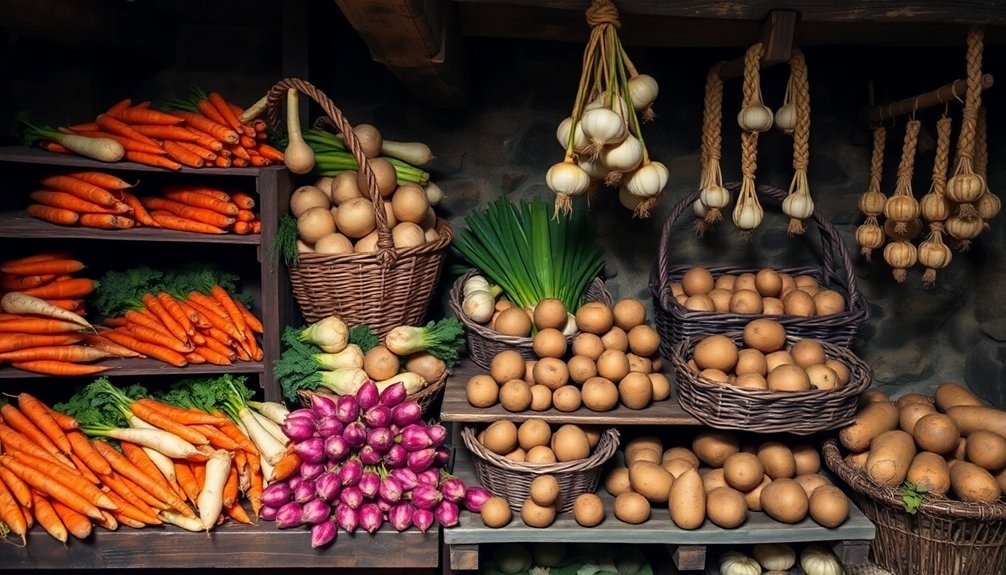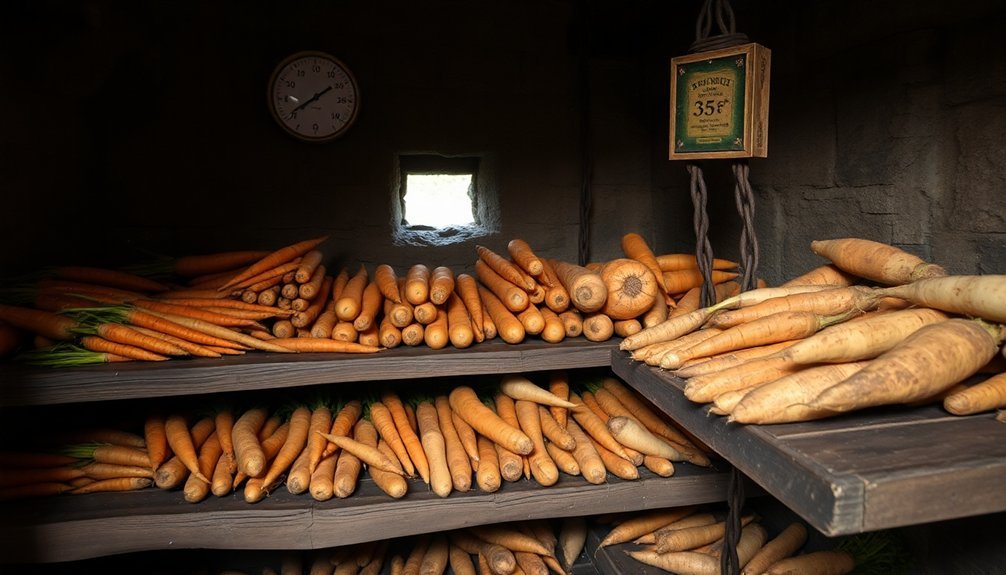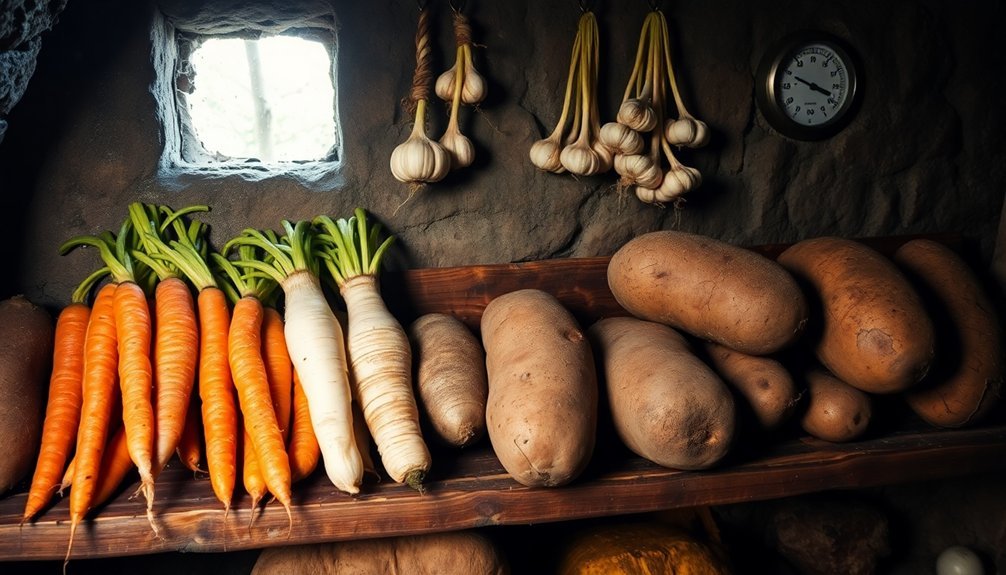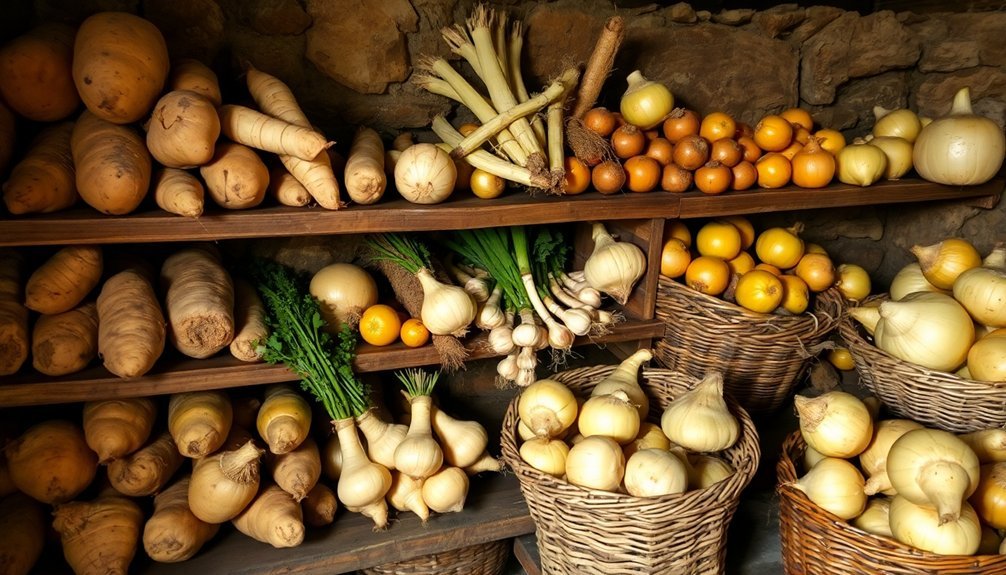You'll get the longest storage life from potatoes, onions, and beets in your root cellar, with each lasting up to 9 months when stored properly. Keep your potatoes and beets at 32-40°F with high humidity (85-95%), while onions prefer the same temperature but lower humidity (60-70%). Don't store potatoes and onions together, as they'll cause each other to spoil faster. For best results, cure your vegetables before storage and maintain proper ventilation to prevent mold growth. Understanding the specific storage needs of each vegetable will help you maximize their shelf life in your root cellar.
Understanding Root Cellar Basics

Anyone interested in long-term root vegetable storage needs to understand the fundamentals of root cellaring.
You'll need to control four significant factors: temperature, humidity, ventilation, and location to maximize your vegetables' storage life.
Your root cellar should maintain temperatures between 32-40°F (0-4°C). It's vital to prevent freezing below 32°F, which ruins vegetables, while avoiding temperatures above 40°F that trigger sprouting and decay. Traditional farmers have relied on natural insulation methods for generations to maintain these ideal temperatures.
You'll want to maintain humidity levels between 85-95% for most root vegetables, though onions prefer it drier. This high humidity prevents produce from drying out and losing quality.
Proper ventilation is essential for preventing mold growth and managing ethylene gas buildup, which can cause premature ripening. You can use fans or passive ventilation systems to keep air circulating effectively.
For ideal storage conditions, consider building your root cellar underground or into a hillside. If that's not possible, you can simulate these conditions using insulation materials like straw bales or foam board.
Don't forget about proper drainage – a dirt and gravel floor helps regulate humidity while preventing excess moisture buildup.
Top Long-Lasting Root Vegetables
Looking to maximize your root vegetable storage?
Potatoes stand as champions with their impressive nine-month shelf life when stored properly at 32-40°F, while beets can keep for up to six months if you maintain proper humidity levels and remove most of their greens. Storing your root vegetables in perforated plastic bags helps maintain optimal moisture while allowing necessary airflow.
Your success with long-term storage also depends on keeping certain vegetables separate, such as potatoes and onions, even though both vegetables handle cold temperatures remarkably well.
Beets Lead Storage Time
Gardeners prize beets as one of the longest-storing root vegetables when properly maintained in a root cellar. You'll find that beets can last an impressive 5-10 months when stored under ideal conditions of 32-40°F with 90-95% humidity.
To achieve this extended shelf life, you'll need to store your beets in damp sand, peat moss, or sawdust while ensuring they don't touch each other. Canning and pickling are also excellent options as they provide added shelf stability while enhancing flavor.
To maximize your beets' storage potential, follow these essential practices:
- Remove beet greens immediately to prevent moisture loss and decay
- Leave dirt on the beets rather than washing them
- Store in a dark environment to prevent sprouting
- Maintain consistent moisture in your storage medium
- Check regularly for signs of rot and remove affected beets promptly
Your beets will outperform many other vegetables in storage longevity. While Brussels sprouts last only 4 weeks and cauliflower manages just 3 weeks, your properly stored beets will rival carrots and parsnips in their 6-month storage capacity.
Only onions, lasting up to 9 months, exceed beets in storage duration. Remember to maintain proper air circulation by using containers with loose-fitting lids.
Potatoes Stay Nine Months
Among all root vegetables, potatoes stand out as storage champions, with a remarkable shelf life of up to nine months when properly stored.
You'll need to maintain temperatures between 40-50°F and relative humidity of 80-95% to achieve ideal storage conditions. Keep your potatoes in complete darkness to prevent greening and potential toxicity.
Before storing your potatoes, let them cure at 60-75°F for two weeks to heal wounds and toughen their skins. Don't wash them before storage; instead, let them dry naturally.
Place them in open plastic crates, baskets, or paper bags that allow proper ventilation. During the first two weeks after harvest, provide 6-9 hours of ventilation every few days.
You'll want to keep potatoes away from onions, bananas, and other ethylene-producing fruits that can trigger premature sprouting.
If your potatoes develop a sweet taste from cold temperatures, you can recondition them by storing at 70°F for a week or two.
Remember to maintain stable temperatures, as fluctuations can lead to early sprouting. Once your potatoes enter dormancy after week four, you won't need additional ventilation to maintain their quality.
Onions Endure Cold Well
Onions rival potatoes in their remarkable storage capabilities, with properly stored bulbs lasting up to a year in perfect conditions.
You'll want to maintain temperatures between 35-40°F with 60-70% humidity in a dark space that allows proper air circulation. Before storing, cure your onions for several days in a dry location and remove foliage, but don't wash them or peel off their protective skin.
For ideal storage success, choose one of these proven methods:
- Mesh bags that promote airflow and prevent moisture buildup
- Pantyhose segments, tying knots between each onion
- Open bins placed on elevated shelves
- Shallow baking dishes for easy monitoring
- Hanging systems that keep bulbs off the ground
You'll need to check your stored onions regularly for signs of sprouting or softening.
The key to extending their shelf life lies in maintaining consistent environmental conditions. A root cellar, basement, or temperature-controlled garage provides a perfect setting.
Remember, proper air circulation is essential – it prevents moisture accumulation that can lead to rot.
With these storage practices, you'll have fresh onions available for cooking throughout most of the year.
Optimal Storage Temperature Guidelines

Successfully storing root vegetables depends heavily on maintaining the right temperature range. You'll want to keep most root vegetables between 32 and 40 degrees Fahrenheit, though there are some exceptions. Sweet potatoes prefer warmer conditions, while garlic and onions thrive in cool, dry environments.
| Vegetable | Ideal Temp (°F) | Storage Life |
|---|---|---|
| Potatoes | 32-40 | 5-8 months |
| Carrots | 32-40 | 6 months |
| Parsnips | 32-40 | 2-6 months |
| Turnips | 32-40 | 5 months |
To maximize storage life, you'll need to protect your vegetables from temperature extremes. Don't let them freeze, as this will damage their texture and flavor. Similarly, temperatures above 40°F can trigger sprouting and accelerate decomposition. You'll get the best results by storing your root vegetables in a consistently cool environment, away from heat sources and direct sunlight.
For long-term storage, consider using an insulated storage area or root cellar. When properly stored at ideal temperatures, many root vegetables can last for months. You'll find that carrots, turnips, and rutabagas maintain their quality for 5-6 months, while potatoes, garlic, and onions can last even longer.
Humidity Requirements By Vegetable Type
You'll find two distinct groups of root vegetables when it comes to humidity needs: those requiring high moisture levels around 90-95% (like carrots, beets, and parsnips) and those needing lower humidity between 65-70% (such as onions, garlic, and shallots).
To maintain proper moisture for high-humidity vegetables, you can use damp sand or sawdust as storage medium, while low-humidity vegetables need well-ventilated containers or mesh bags.
Understanding these different humidity requirements helps you prevent both dehydration in moisture-loving roots and rot in those that prefer drier conditions.
High Vs Low Humidity
Root vegetables require different humidity levels for ideal storage, with most falling into either high-humidity (90-95%) or low-humidity (55-70%) categories.
You'll find that carrots, beets, parsnips, and potatoes thrive in high-humidity environments, while onions, garlic, and winter squash prefer drier conditions. Understanding these requirements is vital for successful long-term storage.
When storing high-humidity vegetables, you'll need to maintain moisture levels without creating wet conditions that promote rot. To achieve this balance, consider these essential storage practices:
- Use perforated plastic bags in refrigerator crisper drawers
- Line storage containers with slightly damp sand
- Keep root vegetables in ventilated containers with moist sawdust
- Monitor humidity levels regularly with a hygrometer
- Inspect stored vegetables weekly for signs of decay
For low-humidity vegetables, you'll want to focus on air circulation and moisture control.
Store onions and garlic in mesh bags or wire baskets, and keep winter squash on shelves with good airflow.
Don't mix high and low-humidity vegetables in the same storage area, as this can lead to premature spoilage and reduce overall storage life.
Moisture Control Methods
Managing moisture levels for different root vegetables requires specific techniques based on their unique storage needs. While most root vegetables thrive in high humidity between 90-95%, some vegetables like onions and squash need drier conditions around 55-60% to prevent mold growth.
You'll need to monitor humidity using a hygrometer and adjust levels accordingly. For vegetables requiring high moisture, place pans of water on the floor and use moist packing materials like sawdust or peat moss. For those needing lower humidity, guarantee proper ventilation, especially during nighttime hours when air tends to be cooler and drier.
| Vegetable | Humidity Range | Storage Duration |
|---|---|---|
| Carrots | 90-95% | 4-6 months |
| Potatoes | 90-95% | 6-8 months |
| Onions | 55-60% | 8 months |
Store vegetables in open containers to promote airflow, and remove any spoiled produce immediately to prevent contamination. For leafy vegetables, replant them in moist packing material with roots attached. When storing strong-smelling vegetables, wrap them individually in newspaper to contain odors while maintaining proper moisture levels. Remember that a fuller root cellar naturally helps maintain higher humidity levels.
Preparing Vegetables For Storage

Proper preparation of root vegetables is essential for maximizing their storage life. You'll need to handle your vegetables gently during harvest to prevent skin damage and remove any that show signs of rot or injury.
Don't wash your vegetables before storage; instead, brush off excess soil and trim the green tops, leaving about an inch of stem.
Many root vegetables require curing before long-term storage. You'll want to cure garlic and onions in the sun for a week, while pumpkins and squash need two weeks to develop a hard protective rind. White potatoes should cure for two weeks in a sheltered spot at 60-75°F.
Here's what you'll need to focus on when preparing your vegetables:
- Handle produce gently to prevent bruising and skin breaks
- Remove all damaged or diseased vegetables immediately
- Trim tops properly, leaving a one-inch stub
- Cure vegetables according to their specific requirements
- Use appropriate containers that allow proper airflow
Once you've properly prepared your vegetables, store them in cool conditions between 32-40°F with high humidity (85-95%).
Keep potatoes in paper containers or baskets, onions in mesh bags, and maintain darkness in your storage area to prevent green potatoes.
Common Root Cellar Mistakes
While proper preparation sets the foundation for vegetable storage, even well-prepared produce can spoil if you make common root cellar mistakes.
Poor temperature and humidity management is the most frequent error – you'll want to keep temperatures between 32-40°F and humidity at 85-95%. If you let temperatures drop below freezing, your vegetables will be ruined, while higher temperatures encourage sprouting and decay.
Another critical mistake is neglecting proper ventilation. If you don't maintain adequate airflow, you're risking mold growth and rot from moisture buildup. You'll need fans or ventilation systems to regulate humidity and prevent ethylene gas accumulation.
Don't forget to create openings for air exchange.
Poor storage practices can also lead to failure. You're making a mistake if you're storing vegetables touching each other or if you're washing root crops completely clean.
Don't store muddy vegetables, but don't remove all the dirt either. If you're storing potatoes, they need to be in covered, ventilated containers to prevent greening.
Remember to monitor conditions regularly with a thermometer and hygrometer, and keep your root cellar dark to prevent light damage.
Additional Foods For Underground Storage

Underground storage extends far beyond traditional root vegetables, offering a diverse range of food preservation options. You'll find that many vegetables and fruits can thrive in the cool, dark environment of a root cellar when stored at the right temperature and humidity levels.
While root vegetables like carrots and beets are common cellar staples, you can successfully store various other produce types:
- Potatoes maintain their quality for months at 40-50°F, and you can even leave them in the ground throughout winter.
- Winter squash varieties such as butternut and kabocha can last up to eight months at room temperature.
- Onions and garlic excel in cool, dry locations with good air circulation, especially when braided or stored in mesh bags.
- Sweet potatoes prefer slightly warmer conditions than regular potatoes and should be kept in paper or burlap bags.
- Hardy greens like kale can remain in the ground for continuous winter harvesting.
To maximize storage life, you'll need to monitor temperature and humidity closely. Different produce types require specific conditions – for instance, cassava needs 32-41°F to prevent vascular streaking, while ginger and horseradish thrive around 54-55°F.
Remember that proper air circulation is essential for preventing moisture-related issues and extending storage life.
Frequently Asked Questions
Can Root Vegetables Be Stored Together With Ripening Fruits?
You shouldn't store root vegetables with ripening fruits since the ethylene gas produced by fruits will speed up spoilage. Keep them separate to maintain freshness and extend their storage life considerably.
How Often Should Root Vegetables Be Checked for Signs of Spoilage?
You should check your stored root vegetables at least once a week. Look for soft spots, mold, unusual smells, or discoloration. Don't forget to remove any spoiled items immediately to prevent spread.
What's the Best Container Material for Storing Root Vegetables?
You'll get the best results using sand-filled containers or wood shavings, as they provide ideal moisture control and insulation. For larger storage, consider underground pits or well-ventilated wooden bins with proper humidity control.
Should Vegetables Be Cleaned of Soil Before Root Cellar Storage?
Don't wash your vegetables before storage; just gently brush off excess soil. You'll want to keep some dirt intact as it helps protect the produce and maintains proper moisture levels during storage.
Can Frozen Root Vegetables Be Moved to Root Cellar Storage?
You shouldn't move frozen root vegetables to root cellar storage. Once they've frozen and thawed, they'll quickly rot and decay. Instead, use frozen vegetables immediately or consider alternative preservation methods like canning.
In Summary
You'll get the longest storage life from properly cured root vegetables like carrots, parsnips, and rutabagas when you maintain consistent temperatures between 32-40°F and humidity levels of 85-95%. Remember to check your stored vegetables weekly for signs of decay, remove any damaged items promptly, and don't wash roots before storing them. With proper care, many root vegetables will keep fresh for 4-6 months in your cellar.





Leave a Reply